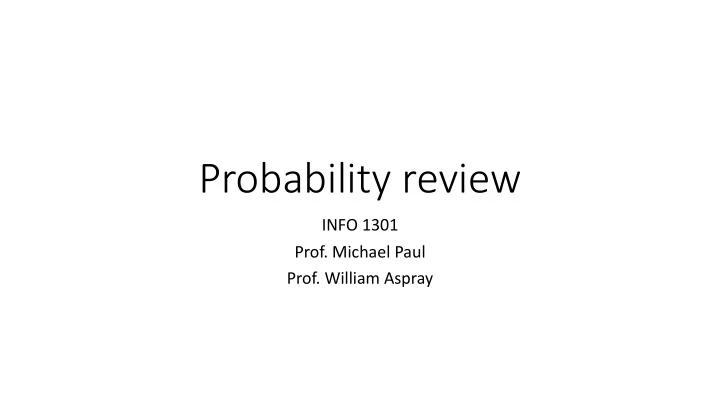

Probability ¡review INFO ¡1301 Prof. ¡Michael ¡Paul Prof. ¡William ¡Aspray
R1 • The probability of an outcome is the proportion of times the outcome would occur if we observed the random process an infinite number of times. • Law ¡of ¡Large ¡Numbers ¡– If ¡you ¡repeat ¡an ¡experiment ¡(e.g. ¡flipping ¡a ¡coin) ¡ enough ¡times, ¡you ¡will ¡get ¡closer ¡and ¡closer ¡to ¡the ¡actual ¡probability ¡of ¡ that ¡event, ¡.5 ¡for ¡heads ¡when ¡flipping ¡a ¡coin ¡or ¡1/6 ¡for ¡getting ¡a ¡3 ¡on ¡a ¡die. • A distribution X is a table of the probabilities of all possible outcomes of a random variable. • The sum of all probabilities in a distribution must equal 1 (or 100%) • For random variables, the standard measure of central tendency is the expected value. • E(x) ¡= ¡expected ¡value ¡of ¡x ¡is ¡given ¡by ¡the ¡formula ¡ E [X] = Σ x P(X = x) x
R2 • If you take the average of multiple outcomes of a random variable, the average will most often be close to the expected value • Central Limit Theorem More formally, the theorem states that if you take the average of multiple random outcomes multiple times, the averages will form a bell curve where the mean is the expected value of that random variable • If two or more outcomes cannot all be true at once, they are called disjoint or mutually exclusive • The complement of an outcome is the set of all other outcomes in the sample space. P(not(x=a)) = 1 – P(x=a)
R3 • The probability that multiple outcomes are true can be described with an AND expression – and is measured by the product if the events are independent of one another. • P(H ¡and ¡5) ¡= ¡P(heads) ¡x ¡P(5) • The ¡probability ¡that ¡any ¡of ¡a ¡set ¡of ¡multiple ¡outcomes ¡can ¡be ¡true ¡can ¡be ¡ described ¡with ¡an ¡OR ¡expression. • If outcomes are disjoint , the probability that any of them are true is the sum of their individual probabilities • P(3 or 5) = P(3) or P(5) If not disjoint , the probability that either outcome is true is the sum of their individual probabilities, minus the probability that they are both true • i.e., P( X OR Y ) = P( X ) + P( Y ) – P( X AND Y )
R4 • The probability of exactly one outcome is sometimes called a marginal probability • For ¡example ¡from ¡class, ¡ Let X be the health status of an individual and Y be the insurance status of the individual P( X = Excellent) marginal probability • The probability that two or more outcomes are all true is called a joint probability • For example, P( X = Excellent AND Y = Yes) joint probability . Also written, P( X = Excellent, Y = Yes) • P( X = Excellent | Y = Yes) conditional probability The probability of an outcome, given that one or more other outcomes are true, is a conditional probability • In this example, we would say that the probability of X is conditioned on Y • In other words, the probability of X if we know Y is true.
R5 • If you know the value of two of these 3 types of probabilities (marginal, joint, conditional), you can calculate the third. • Marginalization: The marginal probability of an outcome can be calculated by summing over all joint probabilities that include the outcome • Rules For any two random variables X and Y with values a and b: P( X = a) = Σ b P( X = a, Y = b) P( X = a, Y = b) = P( X = a | Y = b) × P( Y = b) P( X = a | Y = b) = P( X = a, Y = b) / P( Y = b)
R6 • Two random variables are independent if knowing the outcome of one does not change the probability of the other • If X and Y are independent then: P( X = a, Y = b) = P( X = a) × P( Y = b) • Entropy is a measurement of how evenly distributed a probability distribution is • Entropy of a random variable X is denoted H( X ) • Entropy is non-negative (0 or higher) Lower entropy means it is less even, more certain Higher entropy means it is more even, less certain • The lowest possible value of entropy is 0 • This occurs when a distribution gives 0 probability to all but one outcome • The highest possible value of entropy occurs when the distribution is uniform
R7 How to calculate H( X )? A mess! 1. For every outcome of X , calculate: P( X =a) × log 2 P( X =a) 2. Then sum the results for each outcome: P( X =a) × log 2 P( X =a) + P( X =b) × log 2 P( X =b) 3. Then multiply the final result by –1: – P( X =a) × log 2 P( X =a) – P( X =b) × log 2 P( X =b) General formula: H( X ) = – Σ a P( X = a) log 2 P( X = a)
Recommend
More recommend